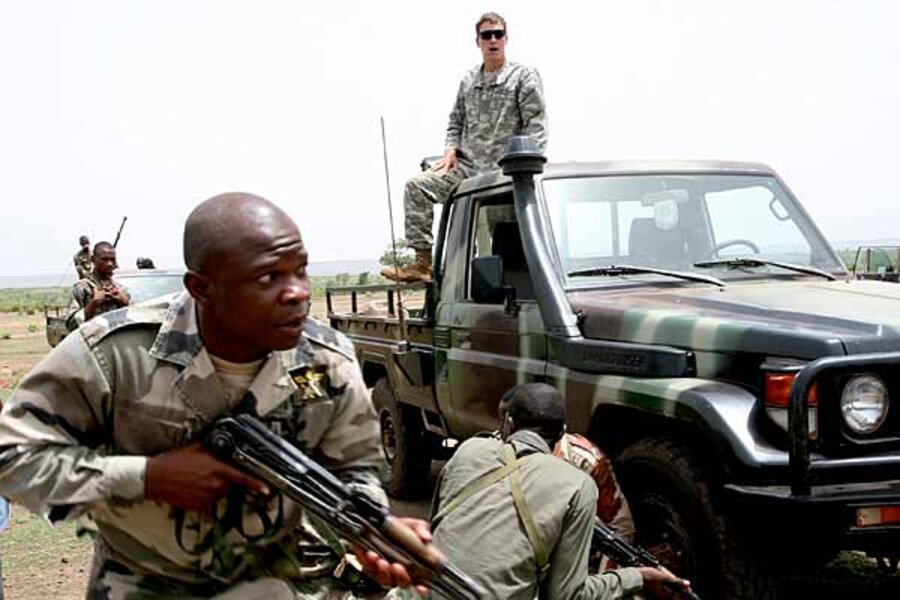Did Qaddafi downfall prompt Mali's Tuareg revolt?
| Bamako, Mali
In November last year a meeting took place in a range of rocky hills in the Sahara Desert in the far north of Mali. A delegation from Mali's parliament had come to meet a group of Tuareg who had a month earlier formed a new alliance. The group called itself National Movement for the Liberation of the Azawad.
The NMLA were a few hundred men camping out in the desert in the most basic conditions – meals of pasta or couscous followed by sweet tea around the camp fire. The movement, however, was talking tough.
They rejected the authority of the parliamentarians – many of whom were the elected representatives for the region the NMLA claimed was not part of Mali – and the NMLA leaders gave the parliamentarians some parting gifts; the flag and the map of what they hoped would soon be their own country, the north of Mali, a region they refer to as the Azawad.
Tuareg separatism
The Tuareg are a traditionally nomadic people who live spread across the Sahara Desert mainly in Mali, Algeria, and Niger. In Mali, the Tuareg have risen up against the central government four times since the country gained independence from France in in 1960. The latest rebellion began on Jan. 17, just a couple of months after that meeting in the desert.
Since then the NMLA have attacked at least seven towns across Mali's north. There have been dozens killed and tens of thousands of people have been displaced internally or been forced to flee to surrounding countries. The fighting risks not only destabilizing Mali, but also its neighbors in the region.
The United States has condemned the attacks by the NMLA and called for talks to end the crisis. The US has a lot invested in Mali. Millions of dollars of US aid money is spent in Mali every year and on top of this, Mali is exactly the sort democracy the US would like to see more of in Africa.
Mali is a key US partner in counter terrorism efforts in West Africa. The militant Islamic group Al Qaeda in the Islamic Maghreb, or AQIM, also has bases in the north of Mali. Already one major US-run counter terrorism training exercise has had to be delayed because of the fighting with the Tuareg rebels.
It is the presence of these two distinct militant movements – the separatist Tuaregs and the radical Islamist AQIM – that has often confused the outside world, says Barbara Worley, an anthropologist at the University of Massachusetts in Boston who has been studying Tuareg society since the 1970s. But there is nothing to suggest that these two distinct movements are coordinating their activities against the Malian government.
“The Tuareg generally practice a moderate form of Islam and reject any form of extremism,” Ms. Worley says.
“What they want is to govern themselves and they want more to see more development in the area they see as traditionally belonging to them.”
But the Malian government has accused the Tuareg of fighting the bloodiest battle so far in the rebellion alongside fighters from AQIM. Although Mali has not said there is an ongoing link between the two groups, Mali says that AQIM militants fought with the NMLA around the town of Aguelhok. The government says dozens of soldiers in Aguelhok were killed on Jan. 24. It is an accusation that the NMLA deny.
Working from within
Not all Tuareg support the current rebellion and there are many Tuareg and those from other ethnic groups who live in Mali's north who think the best way to develop the region is as part of the Malian state. If there were to a referendum on the issue, it’s unlikely a majority of people in Mali's north would vote for independence.
Indeed some argue that the current rebellion would have never have happened had it not been for one thing – the fall of Muammar Qaddafi in Libya. Thousands of Tuareg moved over the years across the Sahara to Libya, mainly attracted to the better standard of living there. Many joined Qaddafi's armed forces. As the Qaddafi regime began to fall most of these Tuareg no longer felt safe in Libya and headed back to Mali. They brought with them weapons and vehicles. The head of the NMLA's military wing is a former Libyan colonel.
Worley says although the Libyan returnees were a major boost for the NMLA these aren't the only people part of the movement.
“The vast majority of the people involved in these rebellions are just young people,” Worely says.
“They are young men with not much military experience, but a lot of passion.”
For the moment it seems that the fighting in Mali is set to continue. After having been put on the back foot in the first days of the rebel, the Malian Army is now fighting back, reclaiming towns it abandoned to the rebels.
The Malian foreign Minister, Soumeylou Boubeye Maiga, said on Tuesday that the government was open to negotiations, but that any power sharing agreement would have to be a system that could also work for the other regions of Mali too.
And with the rebels saying the government must at least accept the principle of self determination for the north of Mali before any talks take place, Mali’s latest Tuareg rebellion could go on for some time yet.





